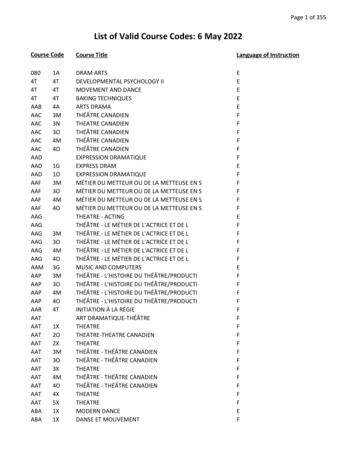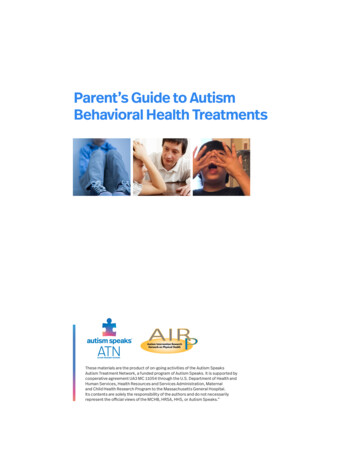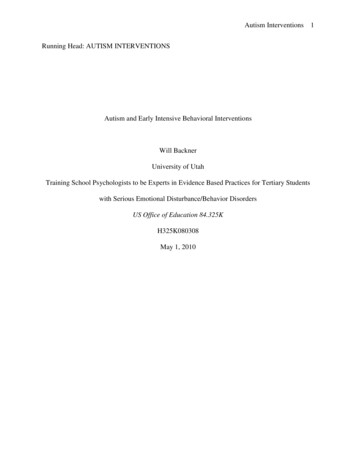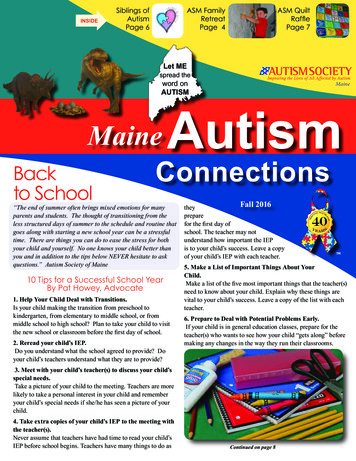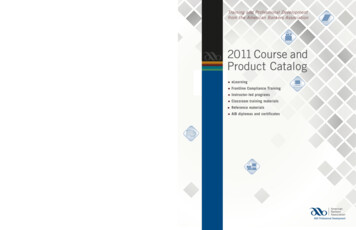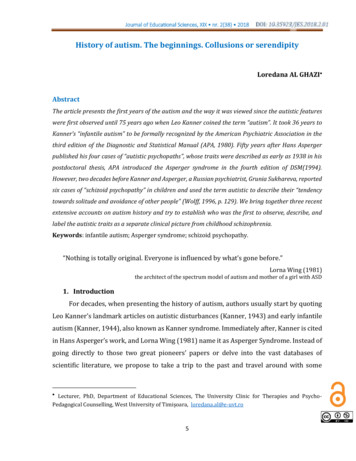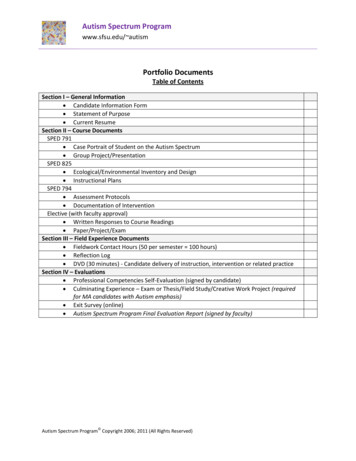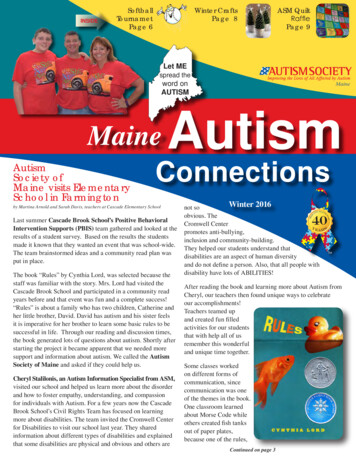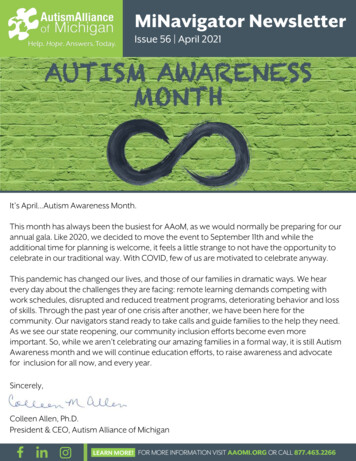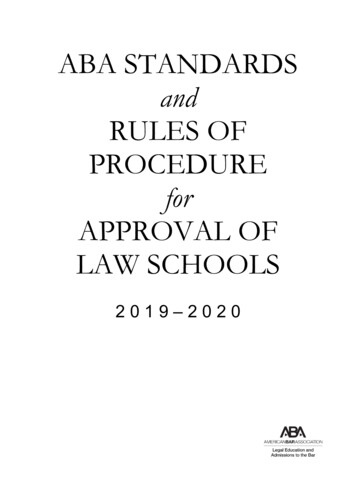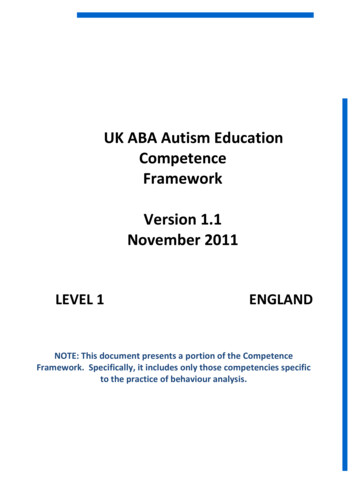
Transcription
UK ABA Autism EducationCompetenceFrameworkVersion 1.1November 2011LEVEL 1ENGLANDNOTE: This document presents a portion of the CompetenceFramework. Specifically, it includes only those competencies specificto the practice of behaviour analysis.
CEIEC
The UK ABA (Applied Behaviour Analysis) Autism Education CompetenceFramework is for practitioners working with children and young people withautism. The project has been funded by Ambitious about Autism, the nationalcharity for children and young people with autism, primarily through generousgrant donations. A project management group, led by Ambitious about Autismand including Bangor University and a parent member, worked with the supportof, and in collaboration with, key stakeholders from the ABA and autismcommunities across the UK.The development of this framework has been possible through the generousdonation of the following organisations and an individual donor:Allan and Nesta Ferguson TrustEvan Cornish FoundationHarold Hyam Wingate FoundationPorticus - UKThe Stavros Niarchos FoundationParent (anon.)UK ABA Autism Education Competence Framework3
What is Applied Behaviour Analysis?Applied Behaviour Analysis (ABA) uses an understanding of why behaviouroccurs to address a wide range of social issues, including helping individuals tolearn. Like other applied sciences, ABA can be applied to a range ofpopulations and settings (e.g., business and industry, education, gerontology,healthcare) and to a range of social concerns (e.g., anxieties, depression,phobia, addiction, behaviours associated with autism). What distinguishes ABAfrom other disciplines is not just that it focuses on behaviour and the context(environment) in which behaviour occurs, but that for behaviour analysts,behaviour and environment are broadly defined. Behaviour encompasses all ofthe activities people engage in (including actions, interactions, talking andthinking) and environment encompasses both the physical and social events,external and internal, that people experience. Behaviour analysts useprinciples of learning and laws of behaviour that have been scientificallydemonstrated, and use clearly defined procedures to specify how to changebehaviour. The effectiveness of any behaviour change intervention iscontinually monitored and evaluated. The primary focus of ABA is onbehaviour that is important to individuals, in terms of enabling them to leadmore fulfilling lives.Practicing behaviour analysts work to achieve positive behaviour change forindividuals, groups of people, and for organizations and society as a whole.Behaviour analysts might be involved in helping to make a positive differenceto behaviour change in any context in healthcare, public health, social care,education, or business. Behaviour analysts work with people to help achievebehaviour change by using ABA-based intervention approaches.UK ABA Autism Education Competence Framework4
Our ValuesIn common with other helping professions, behaviour analysts always aim: to do no harmto ensure that people are safe and feel secureto promote the right of every individual to beneficial help and supportirrespective of intellectual ability, age, culture, gender, sexuality, orother backgroundto work in the best interests of individuals and their families and carersIn addition, the practice of behaviour analysis is characterised by thefollowing commitments: ambition for the person, and optimism about what is possible for theman assumption of every person’s ability to develop and learna determination not to limit expectations by basing them onassumptions about a person’s disabilitiesempowering the individual by establishing skills that enable thedevelopment and management of their own behaviourusing feedback from individuals and their families and carers to amendinterventionsto build on, and facilitate, learning by using the individual’s interests andpreferencesthe development of strengths as a part of any intervention designed tominimise difficultiesa recognition that learning is lifelong, and includes skills in all areas oflifeusing evidence of what is and is not working for each individual to guidedecision makingadapting practice according to new and emerging evidence in the widerprofessional environmentcollaborative working with other professionals, family members, andcarers to best support the individualUK ABA Autism Education Competence Framework5
What is the UK ABA Autism Education CompetenceFramework?The UK ABA Autism Education Competence Framework is a detailedframework of the knowledge and demonstrable behaviours (i.e., things thatcan be demonstrated to another person) that are important for anyone inUK education settings working with children and young people with autismusing ABA1.Section 1 of the framework will provide a clear, professionaldevelopment pathway for those wishing to pursue a career in ABA andis compatible with the internationally recognised Behaviour AnalystCertification Board (BACB ) credentialing. Taken as a whole, theframework is intended to provide a more general professionaldevelopment pathway for anyone working with children with autismwithin the field of education, but will also, as a later development, maponto the UK Qualifications and Credit Framework."As a result of the Framework it is envisaged that: More children and young people with autism will benefit from highquality, evidence-based education delivered by competentprofessionals. Practitioners will benefit from professional development andoccupational standards. Parents and organisations supporting the education of children andyoung people with autism will be able to employ practitioners with agreater degree of certainty about competence and quality. Education providers and the academic community will have a greaterunderstanding of the nature and use of ABA in educational practicefor children with autism.1For an understanding of how the framework was developed, and background to the project see Denne, L.D.,Hastings, R., Hughes, J.C., Bovell, B., & Redford, L.(2011). Developing a Competence Framework for ABA andAutism: What Can we Learn From Others? European Journal of Behaviour Analysis 12 (1) 217 – 230.UK ABA Autism Education Competence Framework6
Who is the Framework for?The UK ABA Autism Education Framework is relevant to anyone whoworks with, provides services for, or is a recipient of services forchildren or young people with autism using ABA.The Framework is also useful for training providers who may wish toidentify, and develop assessments of, competencies.The Framework may be used to inform the development of acurriculum and qualifications for those who work with children andyoung people with autism.UK ABA Autism Education Competence Framework7
Applied Behaviour AnalysisABA.1Definition, Characteristics and Scope of Applied Behaviour AnalysisKnowledgeK.1You know that Applied Behaviour Analysis (ABA)uses an understanding of why behaviour occursto address a wide range of social issues,including helping individuals to learn.K.2You know that ABA, like other applied sciences,has many applications. This means that it can beapplied to a range of populations and settings(e.g., business and industry, education,gerontology, healthcare) and to a range of socialconcerns (e.g., anxieties, depression, phobia,addiction, behaviours associated with autism).K.3You know that what distinguishes ABA from otherdisciplines with similar aims is not just that itfocuses on behaviour and the context(environment) in which behaviour occurs, but thatfor behaviour analysts, behaviour andenvironment are broadly defined (see K.9 & K.17)K.4You know that the primary focus of ABA is onbehaviour that is important to individuals, in termsof enabling them to lead more fulfilling lives.K.5You know that every programme andintervention within that programme is tailored tomeet the needs of each learner, and changesover time using feedback from observed andmeasured changes in the behaviour of thatlearner.K.6K.7Demonstrable BehaviourD.1You give examples of the use of2ABA with the learners you workwith as well as applications fromother populations and settings.D.2You describe behaviour only interms of the characteristics that youobserve.You know that the generation and use ofevidence is integral to ABA and that this includesevidence of the basic principles of behaviour,evidence of the application of these principles inpublished intervention studies and, critically, thateach intervention used with a learner is evaluatedon an ongoing basis by gathering informationabout changes in behaviour.D.3You accurately and consistentlyfollow the data collectionprocedures selected by yoursupervisor.You know that to ensure an intervention workseffectively it must be used by everyoneD.4You accurately and consistentlyfollow procedures selected by your2Glossary items are shown in blue the first time they appear in the text.UK ABA Autism Education Competence Framework8
responsible for its delivery accurately andconsistently across settings.K.8supervisor.You know that a number of interventions that areapplied in a wide range of settings are based onABA (e.g., Picture Exchange CommunicationSystem (PECS); Pivotal Response Teaching(PRT); Precision Teaching; FunctionalCommunication Training; Self-Management;Modelling).UK ABA Autism Education Competence Framework9
ABA. 2:Principles, Processes and ConceptsKnowledgeDemonstrable BehaviourBehaviour and ResponseK.9You know that behaviour is the activity of allliving beings. Human behaviour is whatpeople do, including actions, interactions,and movements.D.5You give examples of your own behaviourand the behaviours of the learners youwork with.K.10You also know that language (what peoplethink, say and remember) is behaviour.K.11You know that many complex daily livingskills can be broken down into a collection ofmore precisely defined behaviours (e.g.,brushing one’s teeth involves identifying andpicking up the toothpaste, taking off the lid,identifying and picking up your owntoothbrush, squeezing toothpaste on thetoothbrush etc.).D.6You give examples of the behaviours thattogether make up common daily livingskills.K.12You know that a response is a singleinstance of behaviour.D.7You give examples of responses from yourown behaviour and the behaviours of thelearners you work with.K.13You know that responses can share thesame form but have different functions (e.g.,waving one’s hand can be used to saygoodbye or to attract attention); and havethe same function but different forms (e.g.,waving your hand or shouting can both beused to attract attention).D.8You distinguish between the form andfunction of behaviour.K.14You know that behaviour is described anddefined using observable and measureabledimensions.D.9You describe your own behaviour and thebehaviour of those with whom you work inprecise, observable, and measurableterms.K.15You know that the observable dimension ofbehaviour is its physical form – (physicalform is also called topography).D.10You describe a response (a singleinstance of behaviour) in precise,observable, and measureable terms.K.16You know that the measurable dimensionsof behaviour include: the number of times it occursUK ABA Autism Education Competence Framework10
( i.e. it can be counted)when it occurs (i.e. the timecan be specified)the length of time it occurs for(duration)its intensity (the force withwhich it occurs)its location (where it occurs)Environment and StimulusK.17You know that the Environment is thecollection of all stimuli that can have aninfluence on behaviour and thatEnvironment includes internal states suchas pain as well, as external stimuli such asthe doorbell ringing.K.18You know that a stimulus is any change inthe environment that can affect behaviour.Relationship between behaviour andenvironmentK.19You know that most behaviour in appliedsettings has been learned: it occursbecause of the event/s that have set theoccasion for the behaviour to occur(antecedent/s), and because of the eventsthat have typically followed in the past(consequence) that make it more or lesslikely for the behaviour to happen again:D.11You give examples from your ownbehaviour and examples from the learnersyou work with of the relationship betweenan antecedent and a response.D.12You give examples from your ownbehaviour and examples from the learnersyou work with of the relationship betweena response and a consequenceD.13You seek to identify the reason why aparticular behaviour occurs (using theprocedures outlined by your supervisor) byreference to antecedents andconsequences and without makingassumptions about why a behaviouroccurs.D.14You give examples of behaviours thathave increased as a result ofreinforcement, in yourself and in thelearners you work with. the antecedent (e.g., antecedent: thephone rings; response: you pick it up) and the consequence (e.g., response:you pick it up; consequence: youspeak to someone.K.20You know that the consequences that leadto learned behaviour are either reinforcing(increasing behaviour) or punishing(decreasing behaviour).ReinforcementK.21You know that reinforcement is the mostimportant principle of behaviour and that it isused in almost all behaviour changeprogrammes, including the teaching of newskills.UK ABA Autism Education Competence Framework11
K.22You know that reinforcement is thestrengthening of a behaviour as a result ofsomething that has followed that behaviour(a reinforcer) which increases the likelihoodof the behaviour happening again.K.23You know that reinforcers are definedfunctionally (i.e. a reinforcer is any stimulusthat follows a behaviour and, as a result, thebehaviour is more likely to occur in thefuture). A consequence is only a reinforcer ifit has a strengthening effect upon abehaviour.Positive reinforcementK.24You know that positive reinforcement occurswhen a behaviour is followed immediatelyby the presentation of a stimulus and, as aresult, the behaviour occurs more often inthe future.K.25Negative reinforcementYou know that negative reinforcementoccurs when a behaviour is followedimmediately by the withdrawal or terminationof a stimulus and, as a result, the behaviouroccurs more often in the future.D.15You give examples of stimuli and/or eventsthat are positive reinforcers for yourbehaviour and that of the learners that youwork with.D.16You give examples of stimuli and/or eventsthat are negatively reinforcing for yourbehaviour and that of the learners youwork with.D.17You give examples of stimuli and/or eventsoften considered to beunconditioned/primary reinforcers andprovide examples of stimuli and/or eventsoften considered to beconditioned/secondary reinforcers for yourbehaviour and that of the learners youwork with.D.18You do not use punishment unless at thespecific request of your supervisor andwhen you are satisfied that ethicalguidelines have been adhered to.Unconditioned (primary) reinforcers andConditioned (secondary) reinforcersK.26You know that unconditioned reinforcers(often called primary reinforcers) are thosethat require no previous learning (e.g., food,warmth, sensory stimulation) and thatconditioned reinforcers (often calledsecondary reinforcers) are those that haveacquired reinforcing properties as a result ofan association (pairing) with anunconditioned reinforcer (e.g., praise,tokens, task completion).PunishmentK.27You know that although punishment is animportant principle of behaviour it shouldonly be used to change behaviour underexceptional circumstances, only undersupervision and only after appropriateethical review.K.28You know that there are strict ethicalguidelines surrounding the use ofUK ABA Autism Education Competence Framework12
punishment, including the fact thatalternatives to punishment must be triedbefore a punishment procedure is put inplace.K.29You know that punishment is the weakeningof a behaviour as a result of something thathas followed that behaviour (a punisher)which decreases the likelihood of thebehaviour happening again.D.19You give examples of events that may bepunishing for your behaviour and that ofthe learners you work with.K.30You know that punishers are definedfunctionally (i.e. a punisher is any stimulusthat follows a behaviour and, as a result, thebehaviour is less likely to occur in thefuture). A consequence is only a punisher ifit has a weakening effect upon a behaviour.D.20You recognise when a consequence thatyou deliver (including your own behaviour)is inadvertently aversive (and is likelytherefore to function as a punisher) andyou change the consequence.K.31You know that some procedures commonlyused in educational practice, such as timeout and response cost, are punishmentprocedures.K.32You know that, like reinforcement,punishment can occur when a behaviour isfollowed immediately by the presentation ofa stimulus and, as a result that behaviouroccurs less often in the future, or when abehaviour is followed immediately by thewithdrawal or termination of a stimulus and,as a result that behaviour occurs less oftenin the future.K.33Unconditioned (primary) punishment andConditioned (secondary) punishmentD.21You give examples of stimuli and/or eventsoften considered to beunconditioned/primary punishers andstimuli and/or events often considered tobe conditioned/secondary punishers foryour behaviour and that of the learners youwork with.You know that unconditioned punishers(often called primary punishers) are thosethat require no previous learning (e.g., pain)and that conditioned punishers (often calledsecondary punishers) are those that haveacquired punishing properties as a result ofan association (pairing) with anunconditioned punisher (e.g., being told off).Motivating OperationsK.34You know that the effectiveness of aUK ABA Autism Education Competence Framework13
reinforcer can change – something that hasworked in one instance as a reinforcer maynot work on another occasion.K.35You know that this could be because of amotivating operation (MO): something whichmomentarily changes both the effectivenessof a consequence, and the frequency of thebehaviour that has in the past resulted inthat consequence.K.36You know that common motivatingoperations are deprivation (when a learnerhas not had a reinforcer for a long time andtherefore its value is likely to increase) andsatiation (when a learner has had lots of areinforcer in the recent past and therefore itis likely to be of less interest)D.22You recognise when a consequence islikely to be more effective (e.g., a snackbefore lunch) and when it is less likely tobe effective (e.g., a break followingunstructured play) and adjust your use ofthat consequence accordingly.D.23You give examples of S s that evokeresponses in the learners you work with.D.24You identify the antecedent variables (Sand any relevant MOs) and consequencesof any specified instance of behaviour.D.25You incorporate opportunities forgeneralisation and maintenance into allStimulus controlK.37You know that stimulus control is a situationin which some dimension of behaviour isaltered by the presence or absence of aspecific antecedent stimulus (e.g., Stimulus green man shows at a pelican crossing;response cross road)Discriminative StimulusK.38DYou know that a discriminative stimulus (S )is an antecedent stimulus that increases thelikelihood that a response or pattern ofresponding will occur because in the pastthat response or pattern of responding hasDbeen reinforced in the presence of the SD4-term contingencyK.39You know that the 4-term contingency is theinterdependent relationship between anyDmotivating operations (MO), an S ,behaviour and consequence.K.40You know that any consequence-basedbehaviour change programme designedeither to increase or decrease behaviourmust consider all 4 components of the 4term contingency.DGeneralisation and MaintenanceK.41You know that generalisation occurs wherethe effects of a procedure that was used toUK ABA Autism Education Competence Framework14
change a target behaviour spread, such thatsimilar behaviour changes also occur inother situations (stimulus generalisation),other behaviours also change (responsegeneralisation), or the effects endure overtime in the absence of a continuingprogramme (maintenance).programmes.UK ABA Autism Education Competence Framework15
ABA. 3:Increasing Behaviour: Rationale for targets, choosing and monitoringKnowledgeDemonstrable BehaviourRationale for targetsK.42You know that behaviour targets areidentified through an assessment of alearner’s skills, are appropriate to thelearner’s developmental level, and focus onbehaviours that will be helpful to and/or arevalued by them.K.43You know that there are a number ofspecific assessment tools available toassess a learner’s existing level across alldomains: daily living skills, social skills,imitation, play; and you are familiar withthose used in your setting.K.44You know that targets are prioritised interms of the immediate benefits for thelearner and developing the building blocksfor longer term learning (i.e., teaching key orpivotal skills first).D.26You contribute, under supervision, to theassessments carried out in your settingusing the available tools.D.27You use the specified performance criteriawhen working with identified targets foreach of the learners with whom you work.D.28You accurately record data as specified byyour supervisor.Defining performance criteria (Mastery)K.45You know that a target behaviour isdescribed and defined using observable andmeasurable dimensions.K.46You know that the performance criteriaspecify observable or measureabledimensions.Monitoring and changing targetsK.47You know that decision making should bedata driven, and that this necessitatesaccurate data collection as specified foreach intervention.UK ABA Autism Education Competence Framework16
ABA 4:Increasing Behaviour: Consequence based strategies - reinforcementKnowledgeK.48You know that the rationale for usingspecific positive reinforcers with learners isthat you cannot assume any individual willbe motivated by things that typicallymotivate others (praise, imitating peers, andtask completion).K.49You know that the aim when working withany learner is to move towards the use ofnaturally occurring reinforcers (e.g., taskcompletion, praise, school/society basedsystems of reward).Demonstrable BehaviourEstablishing and choosing reinforcersK.50You know it is important to sample a widerange of potential reinforcers across avariety of different sensory modalities (e.g.,tactile – hugs, tickling, heavy blanket;vestibular – rocking, swings; auditory –music, singing; gustatory – sweets, crisps;visual – lights, different colours).D.29You create opportunities for the learner tosample multiple potential reinforcers byproviding items/activities on a noncontingent basis (i.e. items, activities,attention or downtime given to the learnerthat is not dependent on a specifiedresponse).K.51You know the importance of continuouslyestablishing new reinforcers (i.e., because alearner’s interests can be transient andsatiation may come into play).D.30You identify and use a variety of potentialreinforcers for learnersK.52You know how to pair establishedreinforcers with other items/activities/peopleto increase the range of potential reinforcersavailable.D.31You increase the range of potentialreinforcers through pairing items/activitieswith established reinforcers as specified inthe intervention/programme.K.53You know that activities learners engage induring their free time may be used asreinforcers because they are likely to bepreferred activities. Such activities mayinclude aspects of stereotypic/repetitivebehaviour.D.32You choose a learner’s high preferenceitems or activities as potential reinforcersduring teaching.D.33You choose as potential reinforcers itemsor activities that appear to have the samefunction as a learner’s preferred items oractivities.K.54You know a range of procedures to identifywhat is potentially reinforcing for a learner atany time (e.g., asking, observing, formalpreference assessments).D.34You use a range of procedures to selectpotential reinforcers.K.55You know the significance of varyingreinforcers in a session (i.e., to reduce thechances of satiation).D.35You continuously assess the environmentto inform the selection and use ofreinforcersUK ABA Autism Education Competence Framework17
K.56You know the importance of maintaining thevalue of reinforcers and that if reinforcersare available at other times (i.e., when theyare not contingent on a target behaviour)then they will become less effectiveD.36You ensure, where possible, thatreinforcers are not available noncontingently other than if pre-determinedby your supervisor (see section on NonContingent Reinforcement K.167).K.57You know that primary reinforcers are mostoften used during the early stages ofintervention and also understand theimportance of fading their use as soon aspossible.D.37You try to avoid relying entirely on primaryreinforcers, and whenever possible youattempt to establish or use conditionedreinforcersK.58You know the ethical implications of usingprimary reinforcers such as the need to usethem in moderation.D.38You abide by ethical guidelines as to whatprimary reinforcers are appropriate foruse, when to use them, and in whatquantities.D.39You fade the use of unconditioned/primaryreinforcers and increase use ofconditioned reinforcers when appropriateunder supervision.K.59You know that the advantages of usingprimary reinforcers include the fact that theydo not depend on learning and can be verypowerful.K.60You know the disadvantages of primaryreinforcers including the fact that they canbe difficult to fade and that their use canseem strange in some environments toother professionals, family members, or thegeneral public.K.61You know that it is important to establishsecondary reinforcers as a step towardsmore naturally occurring reinforcementcontingencies.D.40You pair secondary reinforcement(praise/social attention/activities) withprimary reinforcement on a contingentbasis under supervision.K.62You know the importance of pairing yourown presence with reinforcement: thelearner comes to associate a teachingsession with activities that are of interest tothem, and your praise/socialattention/activities become secondaryreinforcers.D.41You create an environment that motivatesthe learner to interact with you by pairingyour presence with established reinforcers(e.g., praise, smile, toy, tickle) on a noncontingent basis.D.42You initially provide immediatereinforcement of each instance of thecompleted target response when teachingDelivering reinforcement: Schedules ofreinforcementK.63You know that reinforcement can bedelivered following every response (i.e.continuous reinforcement) or intermittentlyUK ABA Autism Education Competence Framework18
(i.e. after a fixed or variable number ofresponses, or fixed or variable amount oftime) and that the way that reinforcement isdelivered (the schedule of reinforcement)affects learning.a new skill.K.64You know that, when working on a new skill,reinforcement should occur after eachresponse (i.e., because it provides thestrongest association between the responseand the reinforcer) Providing reinforcersrapidly also reduces the chances that otherinappropriate behaviours may beinadvertently reinforced.K.65You know that once a skill has beenacquired, it is important to gradually andsystematically thin a schedule ofreinforcement so the learner getsaccustomed to more natural contingenciesof reinforcement (i.e. reinforcers areincreasingly delivered intermittently).D.43You thin a schedule of reinforcement asdirected by your supervisor during a newskill teaching programme.K.66You know that on occasion it may benecessary to temporarily increase thefrequency of reinforcement or return totangible (i.e., something material)reinforcement to maintain motivation.D.44You follow an agreed protocol with respectto the temporary (within session only)relaxation of a schedule of reinforcementbased on a learner’s motivation, anddiscuss any such instances with yoursupervisor.D.45You consistently provide positivereinforcers when the learner is engagingin appropriate behaviour (e.g., remainingon task or using an appropriatecommunicative response rather thanengaging in problem behaviour)D.46You use various token systems toDelivering reinforcement: DifferentialreinforcementK.67K.68You know that programmed differentialreinforcement is the delivery of reinforcers toonly those responses that meet a specifiedcriterion whilst not reinforcing otherresponses.You know that differential reinforcement canbe used to strengthen and shape desirablebehaviour and weaken undesirablebehaviour.K.69You know to look for opportunities toreinforce a learner’s appropriate behavioureven when it is not specifically targeted in aprogramme.K.70You know the importance of relying on thehighest value reinforcers (those whichappear to be most effective) for thosebehaviours that a learner finds most difficult.Delivering reinforcement: Token SystemsK.71You know that a token system is aUK ABA Autism Education Competence Framework19
reinforcement system used when it is helpfulto be able to delay the delivery of a chosenreinforcer until after a certain period of timehas elapsed or an activity has finished, butin the meantime some form of reinforcementis necessary.K.72You know that tokens are generalizedconditioned reinforcement (i.e., that tokenscan be exchanged for a number ofreinforcers).K.73You know that the “back up” reinforcer is theobject or activity/experience that can bepurchased by or exchanged for tokens.K.74You know that strategies to ensure that atoken system remains effective includeadjusting the reinforcement schedule andreassessing the learner’s preferences.increase target behaviours.D.47You deliver a token immediatelycontingent on a target behaviour andmake sure the learner sees that a tokenhas been obtained
What is the UK ABA Autism Education Competence Framework? The UK ABA Autism Education Competence Framework is a detailed framework of the knowledge and demonstrable behaviours (i.e., things that can be demonstrated to another person) that are important for anyone in UK education settings working with children and young people with autism using .
